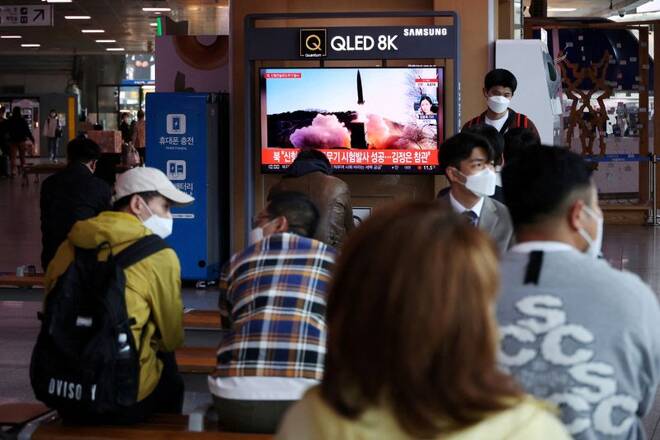Advertisement
Advertisement
Analysis-N.Korea could ‘go small’ with tactical nukes if it resumes testing
By:
By Josh Smith SEOUL (Reuters) - If North Korea resumes nuclear testing, it could include development of smaller “tactical” warheads meant for battlefield use and designed to fit on short-range missiles such as the one tested last weekend, analysts said.
By Josh Smith
SEOUL (Reuters) – If North Korea resumes nuclear testing, it could include development of smaller “tactical” warheads meant for battlefield use and designed to fit on short-range missiles such as the one tested last weekend, analysts said.
South Korean and U.S. officials say there are signs that North Korea is seeking to resume operations in an underground tunnel at its Punggye-ri Nuclear Test site, which was officially shuttered in 2018.
On Saturday, the North test-fired a new, short-range missile that state media said was for “enhancing the efficiency in the operation of tactical nukes,” marking the first time North Korea has linked a specific system to tactical nuclear weapons.
Analysts say putting small warheads on short-range missiles could represent a dangerous change in the way North Korea deploys and plans to use nuclear weapons. It means Pyongyang can field more of them, and instead of threatening a few cities to deter an attack, could use them against a wide range of military targets in the South.
“North Korea doesn’t need to test to deploy tactical nuclear weapons, but it looks like we should expect to see a seventh and perhaps more lower-yield nuclear tests as they go about developing these weapons,” said Ankit Panda of the U.S.-based Carnegie Endowment for International Peace.
North Korea’s previous six nuclear tests saw it detonate progressively larger weapons; the final one was viewed as likely to be a thermonuclear weapon.
“They don’t need to demonstrate that they have a nuclear warhead, but this time they could be demonstrating that they have one small enough to put on a relatively small missile,” said Chun In-bum, a retired South Korean army general. “It significantly increases the dangers on the Korean peninsula and increasingly the capabilities of the North Koreans.”
The weekend missile test, its importance highlighted by the personal presence of leader Kim Jong Un, underscored recent warnings by the North that in a war, it would use nuclear weapons to wipe out the South’s military.
Concerns over North Korea’s recent tests, including what it claims are “hypersonic missiles”, have prompted incoming South Korean President Yoon Suk-yeol to advocate boosting the South’s military deterrent, and to enable possible preemptive strikes if an attack is imminent.
Smaller warheads
There is no universally accepted definition of what a tactical nuclear weapon is, but the term often refers to systems, including land-based missiles for battlefield use with a range of less than 500 km (300 miles).
Their yield, or explosion size, is often smaller than other types of nuclear weapons, although physically smaller warheads can have relatively large yields.
In the depths of the Cold War, both the U.S. and Soviet Union saw tactical nuclear weapons as a means of stopping otherwise catastrophic battlefield advances by their enemies. Because they are less destructive than the larger weapons meant for strategic use, some analysts say there is a risk that leaders might be too willing to launch them.
As early as 2017, the U.S. Defense Intelligence Agency assessed that North Korea could miniaturise nuclear weapons for all of its delivery systems, from short-range ballistic missiles (SRBMs) to intercontinental ballistic missiles (ICBMs).
Kim Jong Un in January 2021 touted the country’s ability to assemble small nuclear warheads and listed making “nuclear weapons smaller and lighter for more tactical uses” as a core strategic task.
Panda said his research showed that the North has several options, including “gun-type” warheads of the sort used in the Little Boy bomb in 1945, and the plutonium-based linear implosion bomb, which has been used for especially small nuclear weapons such as the U.S. W48 artillery shell.
But gun-type weapons use too much highly enriched uranium fuel, and the plutonium-based linear implosion bombs are complex and use too much plutonium. That means North Korea is likely to stick with the standard spherical implosion fission bomb it has already developed.
The warheads already showcased by North Korea appear to be small enough to fit on some of its recently tested KN-23 or KN-24 SRBMs, Panda said, though analysts say it is unclear whether those systems are meant to be nuclear capable.
The Saturday test showed that they have ambitions for even smaller warheads, he said.
“I’d suspect they’d look to test these first as they may opt for a more exotic warhead design to accommodate smaller dimensions,” Panda said.
Such tests could be accompanied by a “show-and-tell” element where Kim visits the Nuclear Weapons Institute and inspects a mocked-up tactical nuclear warhead, he added.
(Reporting by Josh Smith. Editing by Gerry Doyle)
About the Author
Reuterscontributor
Reuters, the news and media division of Thomson Reuters, is the world’s largest international multimedia news provider reaching more than one billion people every day. Reuters provides trusted business, financial, national, and international news to professionals via Thomson Reuters desktops, the world's media organizations, and directly to consumers at Reuters.com and via Reuters TV. Learn more about Thomson Reuters products:
Did you find this article useful?
Latest news and analysis
Advertisement
